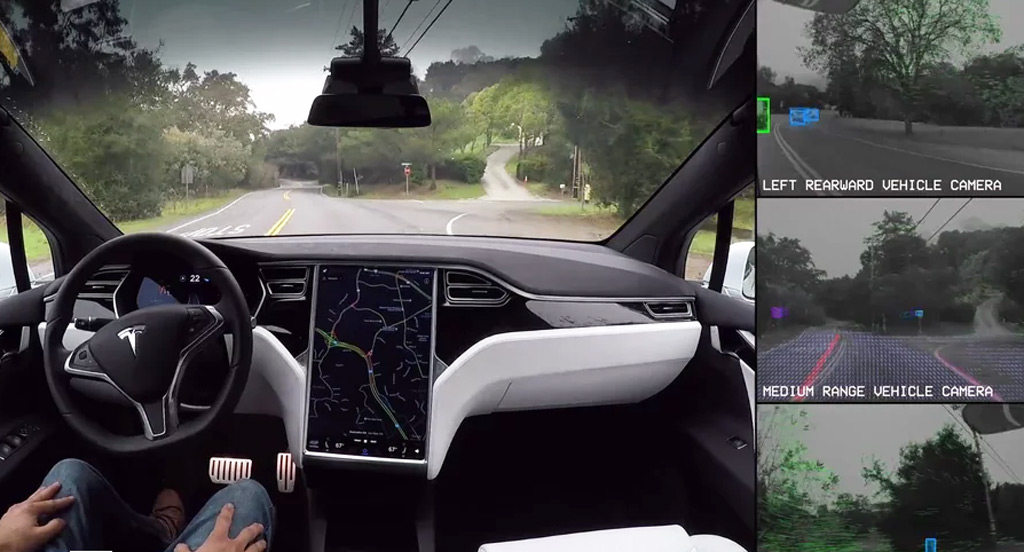A preliminary report released on Thursday by the National Transportation Safety Board has confirmed an important piece of information in the fatal crash involving a 2018 Tesla Model 3 earlier this year: Autopilot was engaged.
On March 1, the Model 3 was traveling southbound on U.S. 441—a divided highway—in Delray Beach, Florida. A semi tractor-trailer was crossing those lanes to turn northbound, but slowed before the turn, obstructing the lane ahead of the electric car, which struck the left side of the semi’s trailer and then continued traveling for 1,600 feet (nearly a third of a mile) from the accident site.
According to the NTSB preliminary report, citing data from the vehicle, supplied with cooperation from Tesla, the vehicle was traveling 68 mph in a 55-mph zone, and the sole-occupant driver, 50-year-old Jeremy Banner, had engaged Autopilot about 10 seconds before the crash. “Neither the preliminary data nor the videos indicate that the driver or the ADAS [advanced driver assistance system] executed evasive maneuvers,” stated the NTSB.
DON’T MISS: Musk: Tesla will introduce Autopilot-informed insurance product next month
"Shortly following the accident, we informed the National Highway Traffic Safety Administration and the National Transportation Safety Board that the vehicle’s logs showed that Autopilot was first engaged by the driver just 10 seconds prior to the accident, and then the driver immediately removed his hands from the wheel,” said a Tesla spokesperson. “Autopilot had not been used at any other time during that drive. We are deeply saddened by this accident and our thoughts are with everyone affected by this tragedy.”
Tesla further noted that its drivers have logged more than a billion miles with Autopilot engaged, and that drivers supported by Autopilot are safer than those without the systems’ assistance.
“For the past three quarters we have released quarterly safety data directly from our vehicles which demonstrates that,” asserted the automaker.
CHECK OUT: Autopilot or not, Tesla adds two more levels of lane assistance
During the first quarter of 2019, Tesla says that it registered one accident for every 2.87 million miles driven in which Autopilot was engaged. The rate for drivers when Autopilot was not engaged was one accident for every 1.76 million miles driven. Tesla compares that to federal NHTSA data citing an automobile crash every 436,000 miles.

Tesla Autopilot
Autopilot employs eight cameras, 12 ultrasonic sensors, and forward-facing radar, but it does not use lidar. Tesla last month introduced a new generation of Full Self-Driving hardware, and reiterated that its neural network and image processing can identify road hazards better than lidar.
The NTSB preliminary report doesn’t make any conclusions about the cause of the accident, as the agency will continue to gather information on the incident, potentially issuing safety recommendations at a later date.
READ MORE: Tesla drivers log 1 billion miles on Autopilot
This is at least the fourth fatal crash involving a Tesla vehicle running Autopilot, and it closely resembles one that occurred near Gainesville, Florida, in 2016.
In that crash, the driver of a 2015 Tesla Model S collided with the trailer of a semi that had swung wide to the right lane to make a left-hand turn. The final Highway Accident Report from the NTSB for that incident found that “The Tesla’s automated vehicle control system was not designed to, and did not, identify the truck crossing the car’s path or recognize the impending crash.” Among many other conclusions, it said: “The way that the Tesla Autopilot system monitored and responded to the driver’s interaction with the steering wheel was not an effective method of ensuring driver engagement.”
Tesla has since phased in a requirement that the driver touch the steering wheel and apply a small amount of torque to it every 20-25 seconds. It’s also expanded the suite of features that are available when Autopilot isn’t in use—like, very recently, active lane control.













